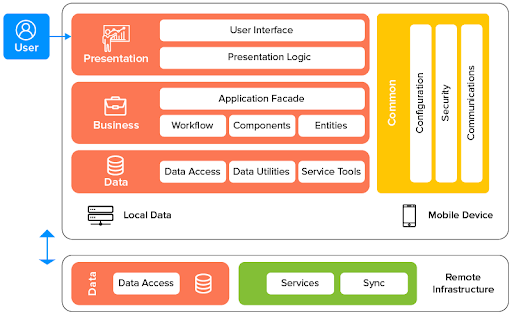A Comprehensive Guide to Mobile App Architecture

When it comes to effective mobile app development then designing mobile app architecture is the first step. Not only first, but it is also one of the most crucial steps as it lays the foundation of the effect mobile app development. No matter if you are a mobile app developer with good hands-on efficacious mobile app development or you are a client that is hiring a team of app developers, you need to ensure that the entire app flow is followed devoutly. If you are new to the mobile app development architecture then things can be difficult for you to understand. So, let us start this race of mobile app architecture from the beginning and by the end of the blog, we hope everything will be clear to you.
What Do You Mean By Mobile App Architecture?
Mobile app architecture in simpler terms can be defined as a set of structural elements along with their interfaces that formulates the system. It basically consists of some effective techniques which help the team of mobile app developers in developing a mobile app and the management team to track the development.
Well, in today’s world of mobile app development the mobile app architecture has become very crucial as it can also be represented as the structure or framework upon which the working and quality of the development is based. If we zoom out then mobile app architecture consists of the UI/UX design, the choice of platform, the tech stack, how the data would move, etc.
Importance of Mobile App Architecture in App’s Success?
When enterprises from different niches approach mobile app development agency then they ask for a development that offers user’s attention, an effective app with no bugs, advanced features that makes the purchase in mobile app easy for the users, and much much more. This demand from the app development company has pressured them to work tirelessly as the clients are demanding the total non-failure of the mobile application. We understand that investing a good amount in the development of the mobile app gives you an idea that your business will be a success.
However, more often than not, the reason behind the failure of an app can be attributed to app development companies paying very little attention to one of the key elements of mobile application development that is mobile application architecture design. So, as an enterprise, if you also want your mobile app to be a success then discussing the key elements and layers of a perfect mobile app architecture design with the mobile app development agency is crucial.
As more and more businesses are moving towards serving their target audience through their very own mobile phones. Mobile app development is the key to winning the marketplace. But you have a robust foundation while you are developing anything so that the further elements do not fall off. That’s what you do with your homes and that’s what you need to do with your business. Mobile app architecture runs on a set of various methodologies and techniques to successfully build a structured mobile app. Here is another thorough guide on a perfect mobile app architecture and its importance.
Elements to be Considered When Developing Mobile App Architecture Design
Device Determination
When it comes to checking mobile app architecture then you need to keep the different types of devices in your mind. It consists of screen size, CPU characteristics, resolution(DPI), storage space, memory, and most important development tool environment availability. Considering types of mobile devices while building app architecture is crucial when you have some special requirements from hardware and software cause you need to have the knowledge of devices that the app will support.
Bandwidth Status
Bandwidth includes when connectivity is either intermittent or not available as your app structure needs to be built by keeping in mind the worst network scenarios. Using mobile app architecture you can design your caching, data access mechanism, and state management considering times of intermittent connectivity.
Right User Interface
We all understand the importance of UI/UX design within an application. A good user interface can easily turn your potential visitors into buyers as it facilitates between the user and your mobile app. Along with aesthetics, it also maximizes the responsiveness, efficiency, and accessibility of your mobile app.
In order to ensure your UI will keep the users engaged and give them some amazing experience, it must be part of your mobile app infrastructure so you know how well it is designed.
Navigation Approach
Navigation Approach is majorly accounted for the app architecture designing front. This element would call for expertise in both the backend and frontend. It must consist of an approach after your understanding of who your customers are and what their app requirements are. You should analyze which one of these would be perfect for your app:
-> Gesture Driven
-> Stacked Navigation Bar
-> Scroll Views
-> Model Controller
-> Search Based
-> Single View
-> Tab Controller
Real-Time Updates vs Push Notifications
When designing your mobile app architecture, find out whether your users need real-time updates or push notifications. Real-time updates can be persuasive but can be an expensive feature to add to your app as this feature drains the phone’s battery and data altogether.
Competition is increasing day by day in every industry as every business is adopting new ways to stand out from their competition. As every business is going online, businesses are adopting mobile applications to enhance their business services. It is expected that mobile app revenue will reach around $80 billion in the coming years. If you want to start from the beginning then everything you need to know about mobile app development architecture.
The Three Layers of Mobile App Development Architecture
All the mobile app architectures are divided into layers. Learning more about them helps the best app development agency understand what architectures are made of. Let us have a look into the three layers of mobile app development architecture.
1. Presentation Layer
The main idea behind these layers is to understand how to present the application to end-users. While designing this layer, the mobile app development agency must find out about the correct client type for the intended infrastructure. Understanding the client’s deployment restrictions should also be in your mind why this mobile app architecture design. Another important aspect is to select the correct data format and use robust data validation mechanisms for protecting the apps from invalid entries.
2. Business Layer
The Business layer talks about the elements on the business front and looks into the way businesses are presented to the end-users. It usually consists of business components, workflow, and the embodies under two sub-categories: Domain Model and Service. The best part of this layer is that this domain model layer looks into the knowledge and expertise linked to specific problem areas.
3. Data Layer
The data access layer must meet the application requirements and should help in offering efficient and secure data transactions. Mobile app developers should also consider the maintenance side of the data while ensuring that the data layer can be modified easily with the changing business requirements. At this third stage data, related factors are kept in mind. This includes data access components, utilities, and service agents. You need to keep in mind that these three components are under the two subheads, precisely, persistence layers and network layer.
Here we have a blog on the mobile app development process: Step by Step Guide 2021. In this blog, we will elaborate on all six phases involved in a mobile app development process. Mobile app development is done to harness the unique features of each device. And if you wish to succeed with your mobile app development process then this is the ultimate guide which you need to read.
The Key Mobile Application Architecture Principles
When it comes to the foundations of a good app architecture in a mobile application ecosystem then a good mobile app architecture best practice is the one that compels with good programming patterns and assumptions. When you meet all these conditions it speeds up the development process which also makes the maintenance easier. A well-designed mobile app architecture in addition to platform-centric technology is best used for solving complex business issues in an effective manner for app projects. Here are the few principles which will also help you to choose the right architecture for your mobile app.
Portability
The portability principle means the system’s ability to react to the changing environment. When we define good architecture design then it ensures that the system is portable enough to make the best of all the answers to changes keeping the impact of those changes at the minimum.
Maintainability
Maintainability means noting down the requirement changes happening due to the environment changes should be modified to correct the faults, better the performance, etc. In such conditions, there is always a need for constant app maintenance. So to ensure your mobile app architecture is good it must offer high maintainability while reducing the efforts needed to keep the system up and running.
Security
Data Security is another major issue in today’s world which makes it absolutely necessary to have it in your application. Your mobile app architecture design must be robust ensuring the data which is consumed by the app. Then it must also be synced with the organization’s security ecosystem, while all the data which is stored on the device must be properly encrypted.
Performance
Performance is the greatest principle which you need to consider while designing mobile app architecture. Because users expect apps to be quick and issues-free and if the app takes a lot of time to fetch the details, the probability of users abandoning the app increases manifold. An effective mobile app architecture should be such that every single one of the users’ expectations is met entirely.
Web Application Architecture is as important as Mobile App architecture as websites and web design company are as important as mobile app development in today’s world. When it is web application architecture then there are two different sets of programs in the Web Applications that run separately yet simultaneously with the shared goal of working for delivering solutions. If you are willing to find out more about the fundamentals of web application architecture then click on the link.
Conclusion
The success of any mobile application strongly relies on its architecture and therefore it is important to pay attention to every detail and what features you plan to include in your application, how you will deploy them, and how all the features in your mobile app will be linked to each other in the architectural layers. As you know there are different types of mobile app architecture, find out which one will suit your needs. Now you know that architecture depends on many factors such as end-users, types of mobile platforms, and resources available. If you find it difficult then we suggest having a chat with an IT consulting company or with a top mobile app development company. An experienced mobile app development company can suggest the right architecture type to choose and the most effective ways to develop your app.








